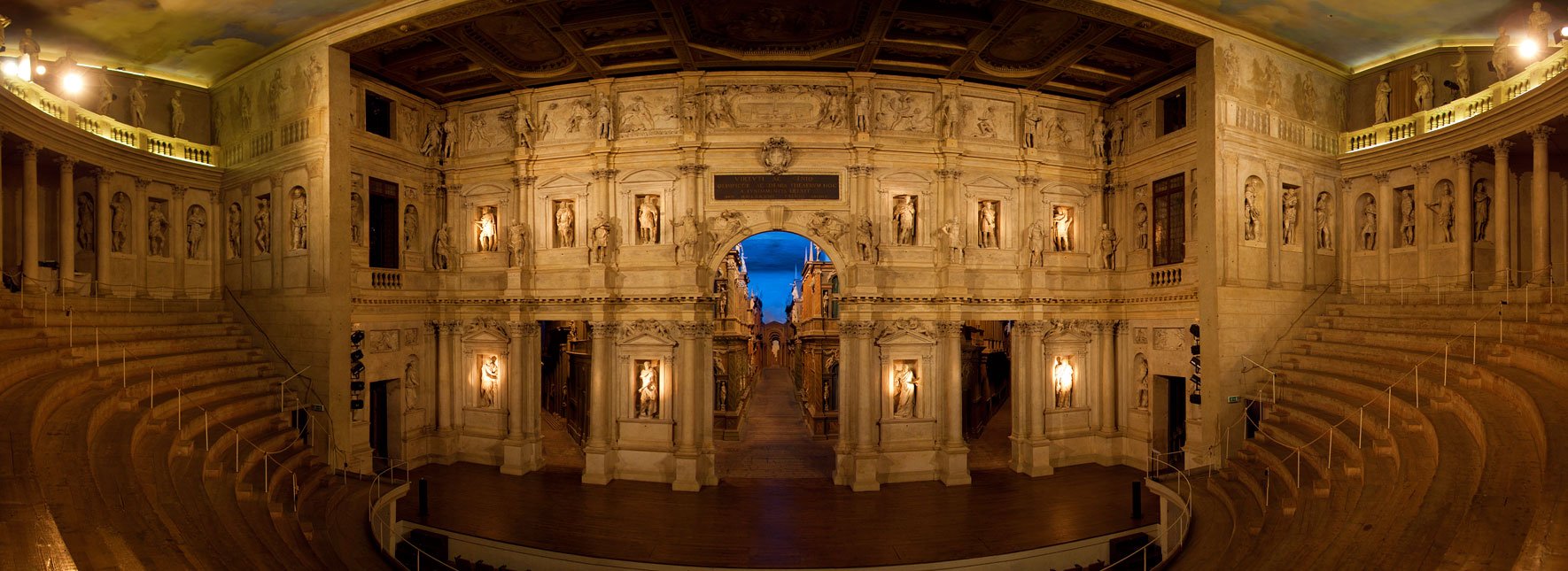Teatro Olimpico
Teatro Olimpico is a theatre in Vicenza, northern Italy, and was constructed in 1580-1585. The theatre was designed by Italian Renaissance architect Andrea Palladio. However, Andrea Palladio wasn’t able to see the theatre’s complete design, as the theatre was completed after his death. The Teatro Olimpico is the last work by Palladio, and ranks amongst his highest masterworks. The Vicentine architect had returned to his native city in 1579, bringing with him a lifetime of detailed study into all aspects of Roman architecture, and a more detailed understanding of the architecture of classical theatre than any other living person. Palladio died after 6 months after construction, this became a sad day. Despite the huge loss, the construction is still continued, and this time Palladio’s son, Silla is now taking charge of the project. After some time, they also called Vincenzo Scamozzi, another prominent Vicentine architect, to help finish the project. The Design of the theatre has been one of Palladio’s greatest works and is also his final work before his death. His designs are really amazing and clearly one of the world’s best. Aside from a single sketch of the scaenae frons, Palladio left no plans as to what kind of scenery should be used onstage. His illustration of an idealized Roman scaenae frons for Barbaro’s edition of Vitruvius had shown perspective street views similar to those which would later be built in the Teatro Olimpico. But the sketch of the proposed scaenae frons for the Teatro Olimpico shows no such street scenes; the space behind the central archway and the doors to each side is blank. The simplest explanation for the absence of any street scenes in this drawing is that the Academy had not yet obtained the land on which the scenery would later be built. However, the land was aquired in 1582 thus they were able to extend the building. They even made a petition to the government for additional land anticipated that if acquired, the space would be used to create perspective scenery. Over the centuries, the Teatro Olimpico has had many admirers, but relatively few imitators. Its unique design and beautiful street scenery makes it more one of a kind. Shakespeare’s famous play, “Rome and Juliet” has been done in this theatre a lot. Many tourists up t this day visit this place. Those who admire literature and the arts are always astonished with Palladio’s beautiful work. The successful completion of Palladio’s experiment in reconstructing the ancient model meant that there was no longer any need to pursue the objective of recovering the Roman past; it was now possible to start making innovations, starting with eliminating the rigid and unchangeable scaenae frons and the unchanging perspective views. Many known actors and actresses visit the place, one of them is Takeru Satoh(starred as Kenshin Himura in the Ruruoni Kenshin Live Action movie in 2012). He went to Italy be a part of a “Romeo and Juliet” play in 2011. He played as Romeo, and it made him have the opportunity to visit Teatro Olimpico. He even got permission to practice on stage, and he read his Romeo’s lines too. The theatre is absolutely beautiful. Many critics and other artists love the design and beauty of this theatre despite being almost five hundred years old. A critic once said:
“In the history of theatre design, the Teatro Olimpico was a temporary hiatus, for succeeding generations adopted the proscenium arch and painterly stage sets. Palladio’s ideas are closer to the spirit of the modern theatre, which favors the relationship of audience to action.”
Andrea Palladio’s work is indeed one of the most beautiful things that we have ever seen. It stood the test of time and is indeed one of the most well designed theatres in the whole world. Preserving this beauty is a must. This will certainly help other people appreciate art and theatre. Theatre acting can never be so without experiencing the beauty of Teatro Olimpico.

